Advanced Finance Exam: DuPont, Leverage, Bonds, and Stock Valuation
VerifiedAdded on 2023/06/12
|11
|2817
|462
Quiz and Exam
AI Summary
This assignment consists of multiple-choice questions covering various topics in finance. The questions test understanding of the DuPont identity and its use in determining financial leverage, operating efficiency, asset utilization, and return on assets. Other questions cover financial leverage, simple and compound interest calculations, present value of annuities, bond valuation (including yield to maturity and interest rate sensitivity), stock valuation (including dividend growth models and rates of return), net present value (NPV), internal rate of return (IRR), profitability index, payback period, and capital budgeting decision-making. The quiz also touches on relevant concepts like opportunity costs, sunk costs, and erosion in project analysis. Desklib provides a platform for students to access more solved assignments and study resources.
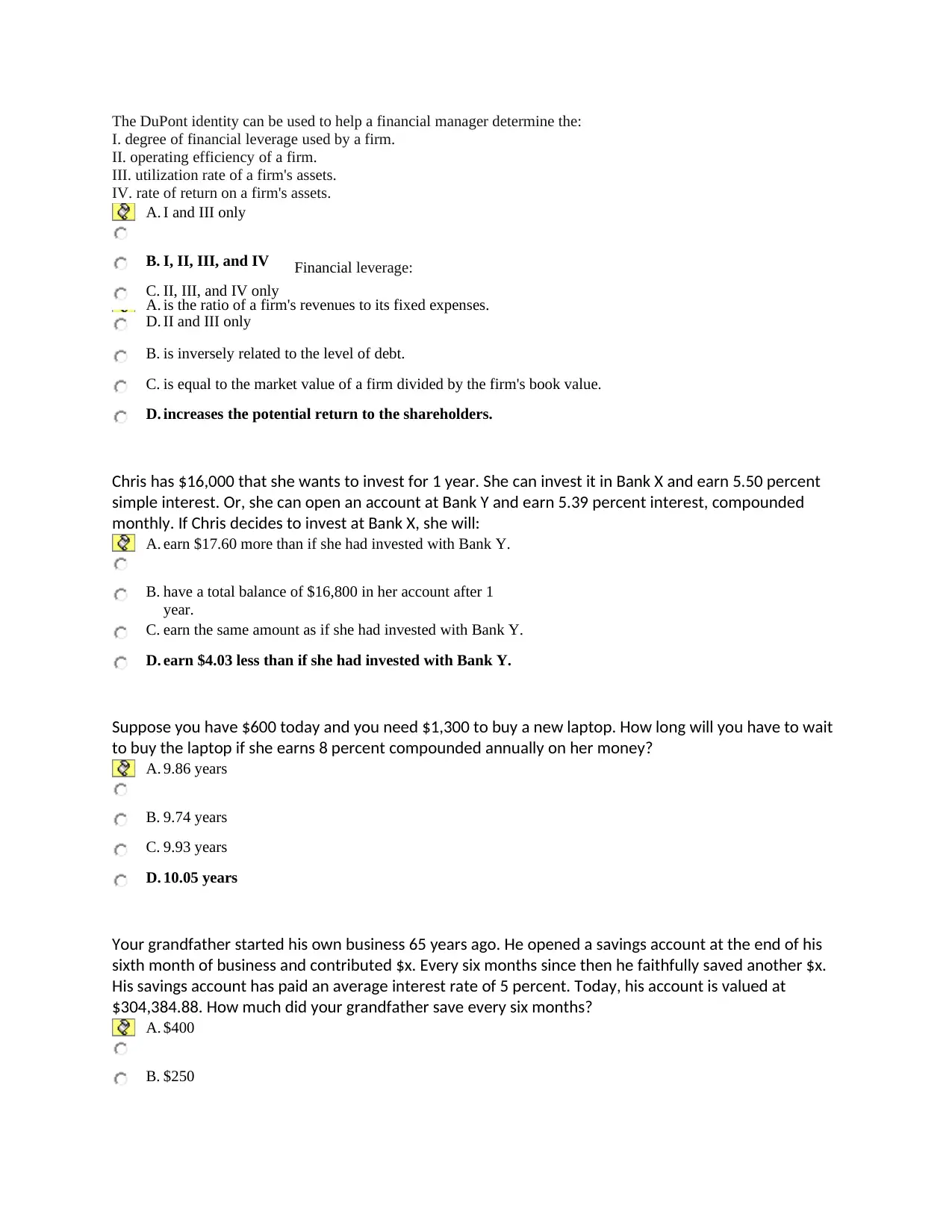
The DuPont identity can be used to help a financial manager determine the:
I. degree of financial leverage used by a firm.
II. operating efficiency of a firm.
III. utilization rate of a firm's assets.
IV. rate of return on a firm's assets.
Financial leverage:
A. is the ratio of a firm's revenues to its fixed expenses.
B. is inversely related to the level of debt.
C. is equal to the market value of a firm divided by the firm's book value.
D. increases the potential return to the shareholders.
Chris has $16,000 that she wants to invest for 1 year. She can invest it in Bank X and earn 5.50 percent
simple interest. Or, she can open an account at Bank Y and earn 5.39 percent interest, compounded
monthly. If Chris decides to invest at Bank X, she will:
A. earn $17.60 more than if she had invested with Bank Y.
B. have a total balance of $16,800 in her account after 1
year.
C. earn the same amount as if she had invested with Bank Y.
D. earn $4.03 less than if she had invested with Bank Y.
Suppose you have $600 today and you need $1,300 to buy a new laptop. How long will you have to wait
to buy the laptop if she earns 8 percent compounded annually on her money?
A. 9.86 years
B. 9.74 years
C. 9.93 years
D. 10.05 years
Your grandfather started his own business 65 years ago. He opened a savings account at the end of his
sixth month of business and contributed $x. Every six months since then he faithfully saved another $x.
His savings account has paid an average interest rate of 5 percent. Today, his account is valued at
$304,384.88. How much did your grandfather save every six months?
A. $400
B. $250
A. I and III only
B. I, II, III, and IV
C. II, III, and IV only
D. II and III only
I. degree of financial leverage used by a firm.
II. operating efficiency of a firm.
III. utilization rate of a firm's assets.
IV. rate of return on a firm's assets.
Financial leverage:
A. is the ratio of a firm's revenues to its fixed expenses.
B. is inversely related to the level of debt.
C. is equal to the market value of a firm divided by the firm's book value.
D. increases the potential return to the shareholders.
Chris has $16,000 that she wants to invest for 1 year. She can invest it in Bank X and earn 5.50 percent
simple interest. Or, she can open an account at Bank Y and earn 5.39 percent interest, compounded
monthly. If Chris decides to invest at Bank X, she will:
A. earn $17.60 more than if she had invested with Bank Y.
B. have a total balance of $16,800 in her account after 1
year.
C. earn the same amount as if she had invested with Bank Y.
D. earn $4.03 less than if she had invested with Bank Y.
Suppose you have $600 today and you need $1,300 to buy a new laptop. How long will you have to wait
to buy the laptop if she earns 8 percent compounded annually on her money?
A. 9.86 years
B. 9.74 years
C. 9.93 years
D. 10.05 years
Your grandfather started his own business 65 years ago. He opened a savings account at the end of his
sixth month of business and contributed $x. Every six months since then he faithfully saved another $x.
His savings account has paid an average interest rate of 5 percent. Today, his account is valued at
$304,384.88. How much did your grandfather save every six months?
A. $400
B. $250
A. I and III only
B. I, II, III, and IV
C. II, III, and IV only
D. II and III only
Paraphrase This Document
Need a fresh take? Get an instant paraphrase of this document with our AI Paraphraser
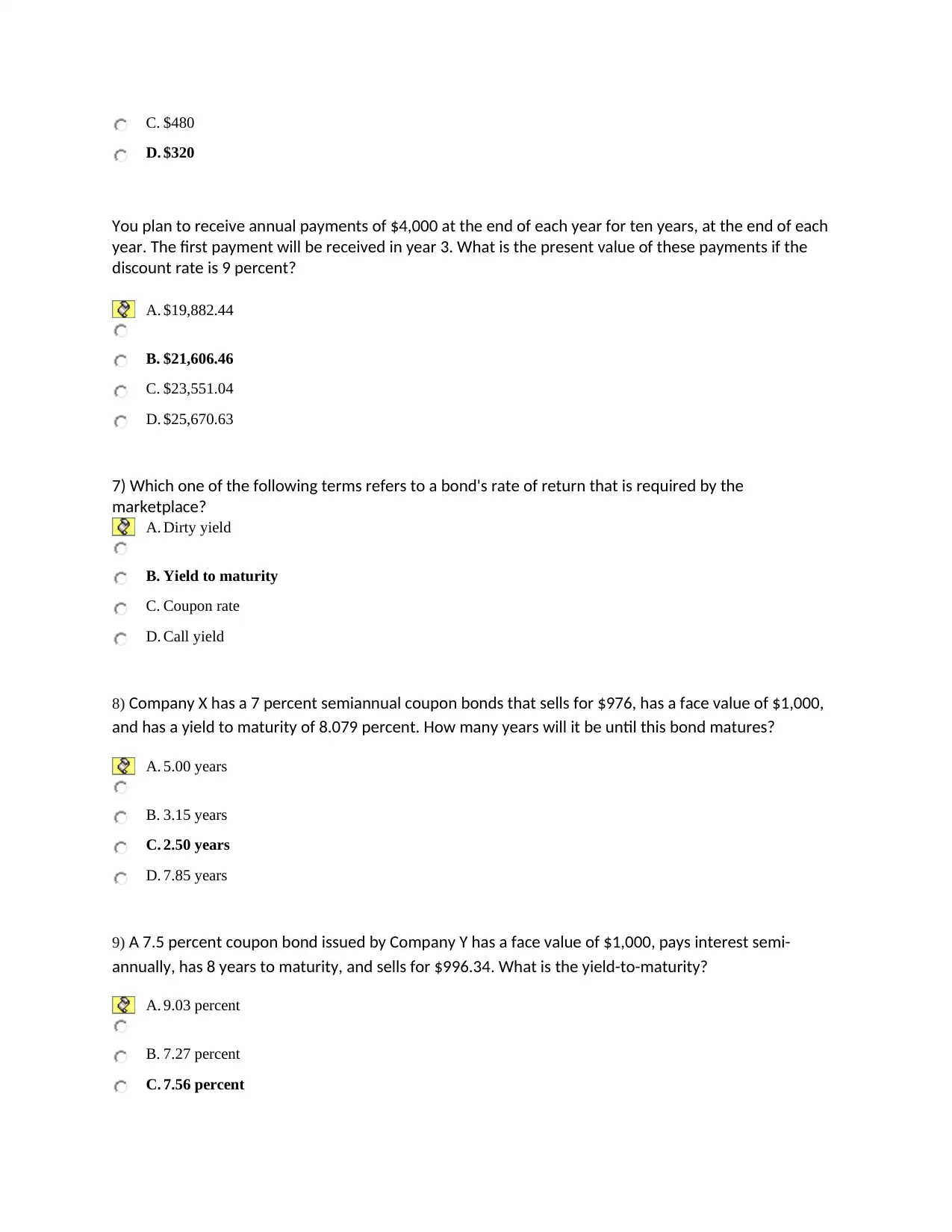
C. $480
D. $320
You plan to receive annual payments of $4,000 at the end of each year for ten years, at the end of each
year. The first payment will be received in year 3. What is the present value of these payments if the
discount rate is 9 percent?
A. $19,882.44
B. $21,606.46
C. $23,551.04
D. $25,670.63
7) Which one of the following terms refers to a bond's rate of return that is required by the
marketplace?
A. Dirty yield
B. Yield to maturity
C. Coupon rate
D. Call yield
8) Company X has a 7 percent semiannual coupon bonds that sells for $976, has a face value of $1,000,
and has a yield to maturity of 8.079 percent. How many years will it be until this bond matures?
A. 5.00 years
B. 3.15 years
C. 2.50 years
D. 7.85 years
9) A 7.5 percent coupon bond issued by Company Y has a face value of $1,000, pays interest semi-
annually, has 8 years to maturity, and sells for $996.34. What is the yield-to-maturity?
A. 9.03 percent
B. 7.27 percent
C. 7.56 percent
D. $320
You plan to receive annual payments of $4,000 at the end of each year for ten years, at the end of each
year. The first payment will be received in year 3. What is the present value of these payments if the
discount rate is 9 percent?
A. $19,882.44
B. $21,606.46
C. $23,551.04
D. $25,670.63
7) Which one of the following terms refers to a bond's rate of return that is required by the
marketplace?
A. Dirty yield
B. Yield to maturity
C. Coupon rate
D. Call yield
8) Company X has a 7 percent semiannual coupon bonds that sells for $976, has a face value of $1,000,
and has a yield to maturity of 8.079 percent. How many years will it be until this bond matures?
A. 5.00 years
B. 3.15 years
C. 2.50 years
D. 7.85 years
9) A 7.5 percent coupon bond issued by Company Y has a face value of $1,000, pays interest semi-
annually, has 8 years to maturity, and sells for $996.34. What is the yield-to-maturity?
A. 9.03 percent
B. 7.27 percent
C. 7.56 percent
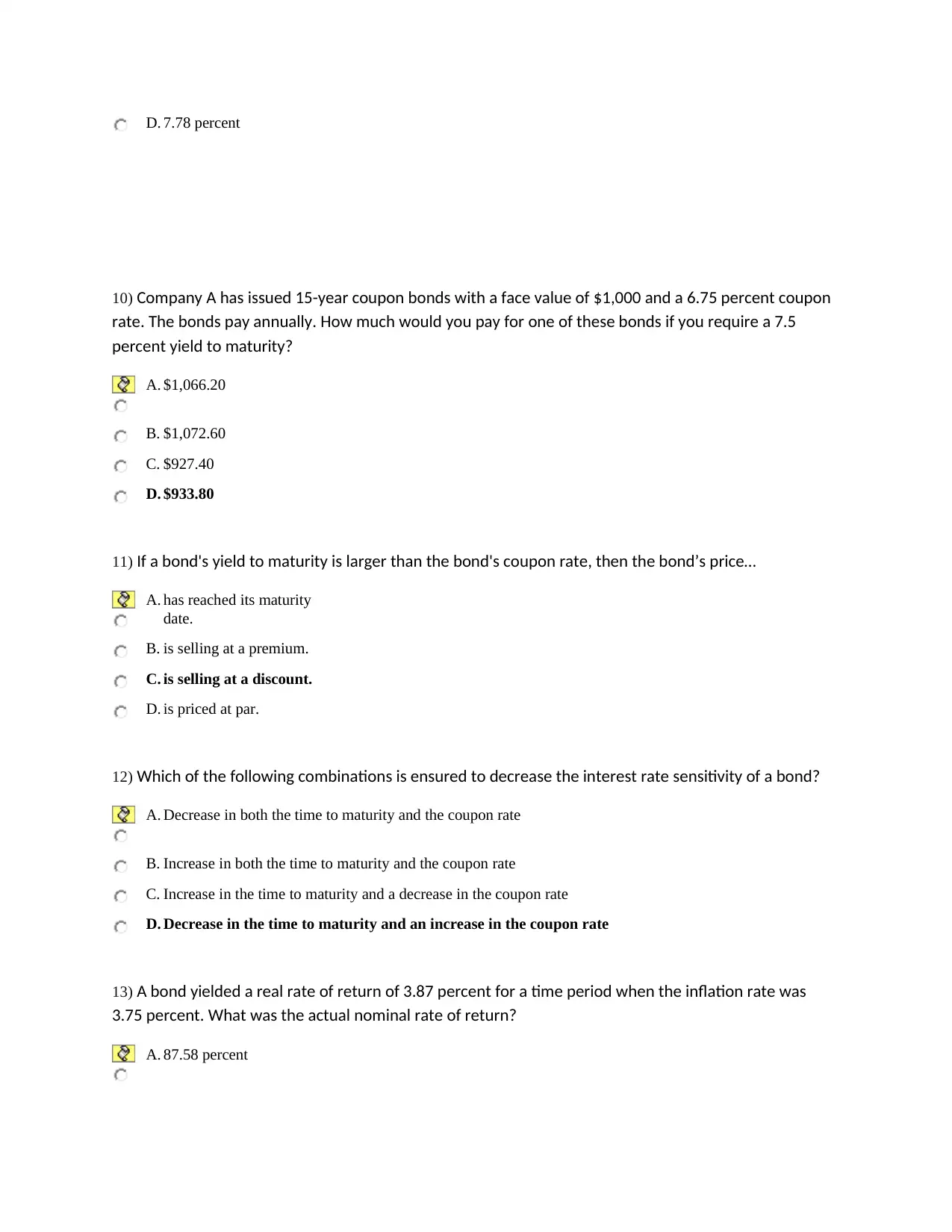
D. 7.78 percent
10) Company A has issued 15-year coupon bonds with a face value of $1,000 and a 6.75 percent coupon
rate. The bonds pay annually. How much would you pay for one of these bonds if you require a 7.5
percent yield to maturity?
A. $1,066.20
B. $1,072.60
C. $927.40
D. $933.80
11) If a bond's yield to maturity is larger than the bond's coupon rate, then the bond’s price…
A. has reached its maturity
date.
B. is selling at a premium.
C. is selling at a discount.
D. is priced at par.
12) Which of the following combinations is ensured to decrease the interest rate sensitivity of a bond?
A. Decrease in both the time to maturity and the coupon rate
B. Increase in both the time to maturity and the coupon rate
C. Increase in the time to maturity and a decrease in the coupon rate
D. Decrease in the time to maturity and an increase in the coupon rate
13) A bond yielded a real rate of return of 3.87 percent for a time period when the inflation rate was
3.75 percent. What was the actual nominal rate of return?
A. 87.58 percent
10) Company A has issued 15-year coupon bonds with a face value of $1,000 and a 6.75 percent coupon
rate. The bonds pay annually. How much would you pay for one of these bonds if you require a 7.5
percent yield to maturity?
A. $1,066.20
B. $1,072.60
C. $927.40
D. $933.80
11) If a bond's yield to maturity is larger than the bond's coupon rate, then the bond’s price…
A. has reached its maturity
date.
B. is selling at a premium.
C. is selling at a discount.
D. is priced at par.
12) Which of the following combinations is ensured to decrease the interest rate sensitivity of a bond?
A. Decrease in both the time to maturity and the coupon rate
B. Increase in both the time to maturity and the coupon rate
C. Increase in the time to maturity and a decrease in the coupon rate
D. Decrease in the time to maturity and an increase in the coupon rate
13) A bond yielded a real rate of return of 3.87 percent for a time period when the inflation rate was
3.75 percent. What was the actual nominal rate of return?
A. 87.58 percent
⊘ This is a preview!⊘
Do you want full access?
Subscribe today to unlock all pages.

Trusted by 1+ million students worldwide

B. 8.28 percent
C. 7.77 percent
D. 7.62 percent
14) Stock X will pay an annual dividend of $2.15 next month. The company just announced that future
dividends will increase by 1.5 percent annually. How much would you pay for one share of this stock if
your required return is 14 percent?
A. $16.13
B. $15.36
C. $17.20
D. $18.06
15) Company A does not expect to pay any dividends for the next three years. Four years from now, the
firm hopes to pay $.60 a share and double that amount each year for the following three years. After
that, the dividend is expected to increase in value by 3 percent annually. What is the price of this stock
today if the required return is 12 percent?
A. $30.38
B. $31.76
C. $29.30
D. $27.13
16) Shares that are sold to the public for the first time are sold:
A. on the NYSE.
B. at the bid price.
C. on NASDAQ.
D. in the primary market.
17) Which one of the following will increase the current value of a stock?
A. Increase in the market rate of return
C. 7.77 percent
D. 7.62 percent
14) Stock X will pay an annual dividend of $2.15 next month. The company just announced that future
dividends will increase by 1.5 percent annually. How much would you pay for one share of this stock if
your required return is 14 percent?
A. $16.13
B. $15.36
C. $17.20
D. $18.06
15) Company A does not expect to pay any dividends for the next three years. Four years from now, the
firm hopes to pay $.60 a share and double that amount each year for the following three years. After
that, the dividend is expected to increase in value by 3 percent annually. What is the price of this stock
today if the required return is 12 percent?
A. $30.38
B. $31.76
C. $29.30
D. $27.13
16) Shares that are sold to the public for the first time are sold:
A. on the NYSE.
B. at the bid price.
C. on NASDAQ.
D. in the primary market.
17) Which one of the following will increase the current value of a stock?
A. Increase in the market rate of return
Paraphrase This Document
Need a fresh take? Get an instant paraphrase of this document with our AI Paraphraser
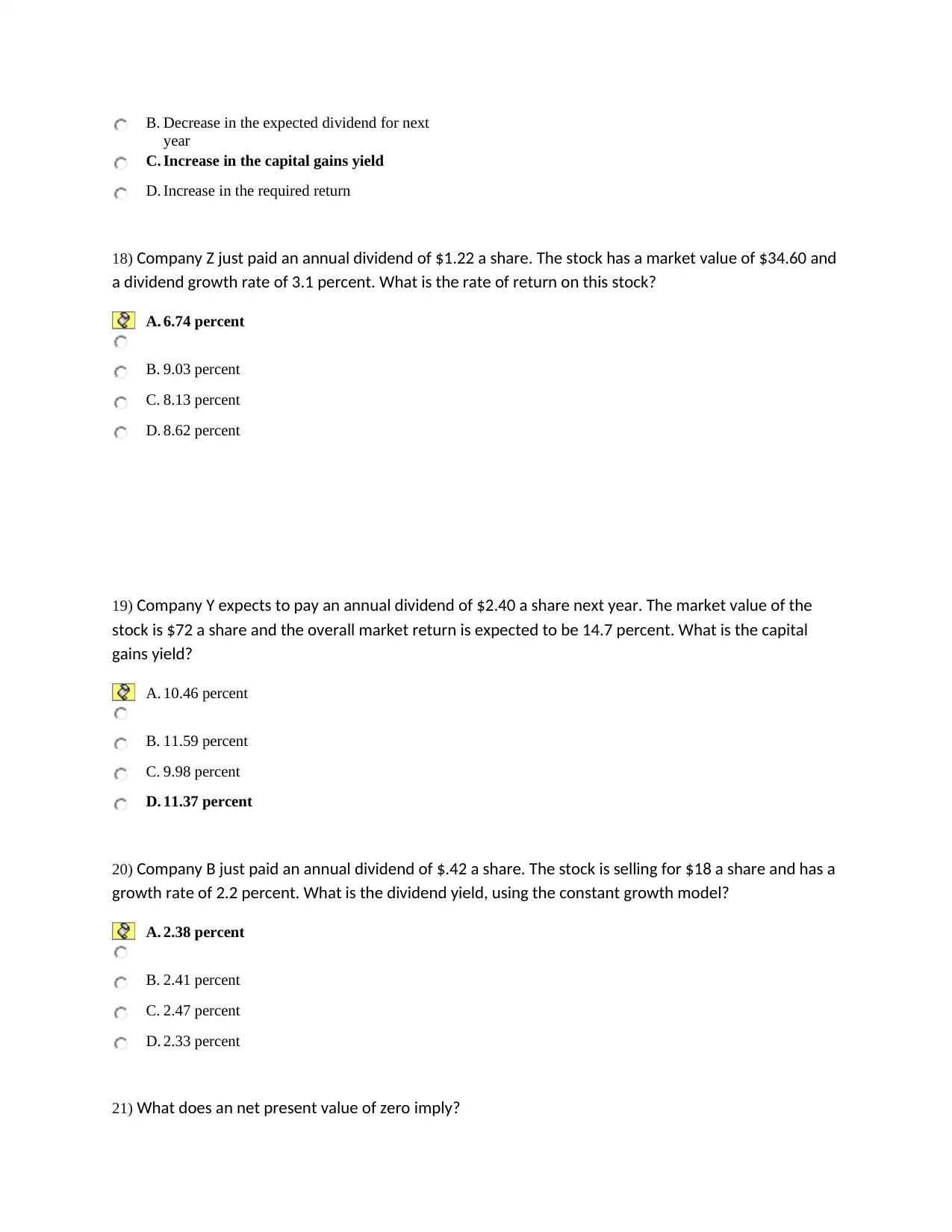
B. Decrease in the expected dividend for next
year
C. Increase in the capital gains yield
D. Increase in the required return
18) Company Z just paid an annual dividend of $1.22 a share. The stock has a market value of $34.60 and
a dividend growth rate of 3.1 percent. What is the rate of return on this stock?
A. 6.74 percent
B. 9.03 percent
C. 8.13 percent
D. 8.62 percent
19) Company Y expects to pay an annual dividend of $2.40 a share next year. The market value of the
stock is $72 a share and the overall market return is expected to be 14.7 percent. What is the capital
gains yield?
A. 10.46 percent
B. 11.59 percent
C. 9.98 percent
D. 11.37 percent
20) Company B just paid an annual dividend of $.42 a share. The stock is selling for $18 a share and has a
growth rate of 2.2 percent. What is the dividend yield, using the constant growth model?
A. 2.38 percent
B. 2.41 percent
C. 2.47 percent
D. 2.33 percent
21) What does an net present value of zero imply?
year
C. Increase in the capital gains yield
D. Increase in the required return
18) Company Z just paid an annual dividend of $1.22 a share. The stock has a market value of $34.60 and
a dividend growth rate of 3.1 percent. What is the rate of return on this stock?
A. 6.74 percent
B. 9.03 percent
C. 8.13 percent
D. 8.62 percent
19) Company Y expects to pay an annual dividend of $2.40 a share next year. The market value of the
stock is $72 a share and the overall market return is expected to be 14.7 percent. What is the capital
gains yield?
A. 10.46 percent
B. 11.59 percent
C. 9.98 percent
D. 11.37 percent
20) Company B just paid an annual dividend of $.42 a share. The stock is selling for $18 a share and has a
growth rate of 2.2 percent. What is the dividend yield, using the constant growth model?
A. 2.38 percent
B. 2.41 percent
C. 2.47 percent
D. 2.33 percent
21) What does an net present value of zero imply?
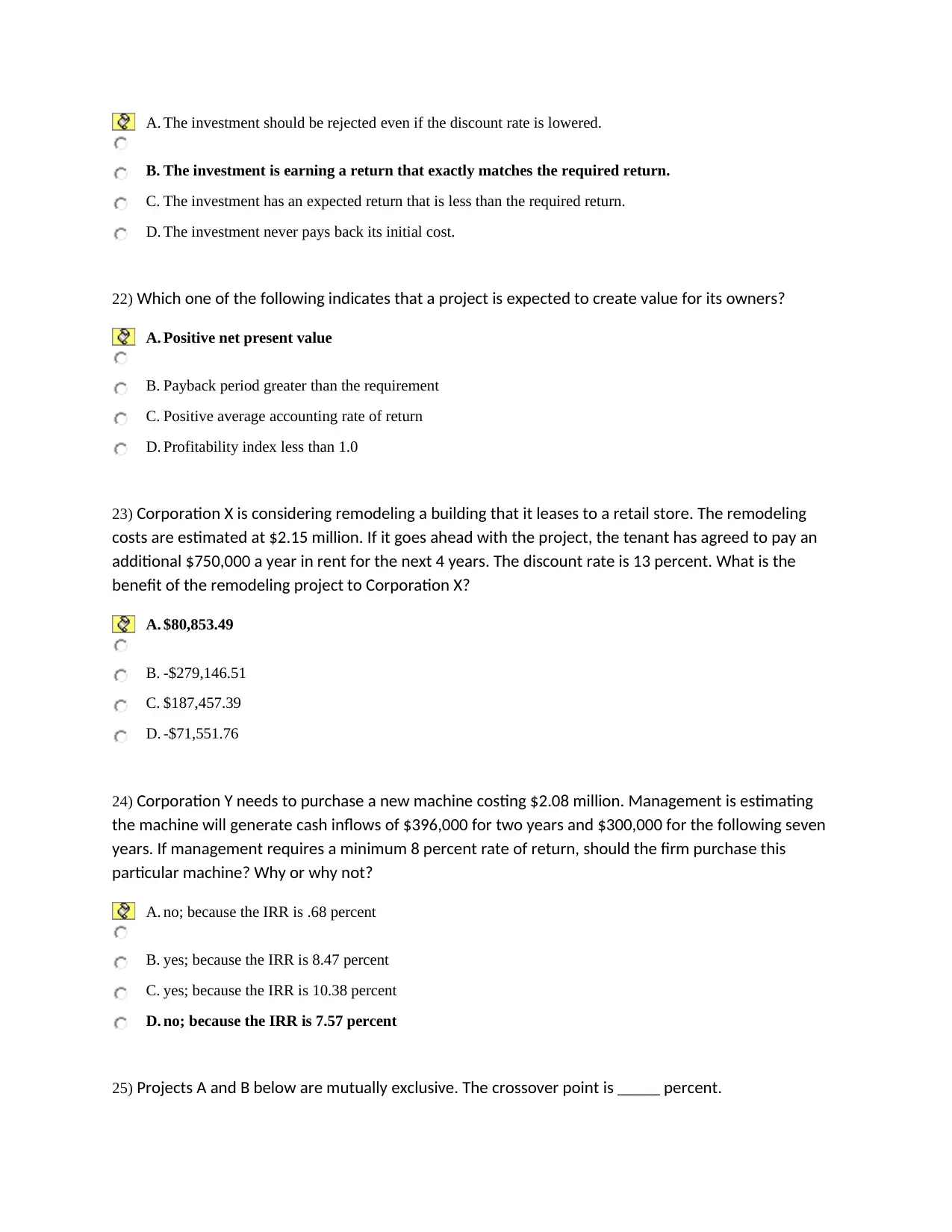
A. The investment should be rejected even if the discount rate is lowered.
B. The investment is earning a return that exactly matches the required return.
C. The investment has an expected return that is less than the required return.
D. The investment never pays back its initial cost.
22) Which one of the following indicates that a project is expected to create value for its owners?
A. Positive net present value
B. Payback period greater than the requirement
C. Positive average accounting rate of return
D. Profitability index less than 1.0
23) Corporation X is considering remodeling a building that it leases to a retail store. The remodeling
costs are estimated at $2.15 million. If it goes ahead with the project, the tenant has agreed to pay an
additional $750,000 a year in rent for the next 4 years. The discount rate is 13 percent. What is the
benefit of the remodeling project to Corporation X?
A. $80,853.49
B. -$279,146.51
C. $187,457.39
D. -$71,551.76
24) Corporation Y needs to purchase a new machine costing $2.08 million. Management is estimating
the machine will generate cash inflows of $396,000 for two years and $300,000 for the following seven
years. If management requires a minimum 8 percent rate of return, should the firm purchase this
particular machine? Why or why not?
A. no; because the IRR is .68 percent
B. yes; because the IRR is 8.47 percent
C. yes; because the IRR is 10.38 percent
D. no; because the IRR is 7.57 percent
25) Projects A and B below are mutually exclusive. The crossover point is _____ percent.
B. The investment is earning a return that exactly matches the required return.
C. The investment has an expected return that is less than the required return.
D. The investment never pays back its initial cost.
22) Which one of the following indicates that a project is expected to create value for its owners?
A. Positive net present value
B. Payback period greater than the requirement
C. Positive average accounting rate of return
D. Profitability index less than 1.0
23) Corporation X is considering remodeling a building that it leases to a retail store. The remodeling
costs are estimated at $2.15 million. If it goes ahead with the project, the tenant has agreed to pay an
additional $750,000 a year in rent for the next 4 years. The discount rate is 13 percent. What is the
benefit of the remodeling project to Corporation X?
A. $80,853.49
B. -$279,146.51
C. $187,457.39
D. -$71,551.76
24) Corporation Y needs to purchase a new machine costing $2.08 million. Management is estimating
the machine will generate cash inflows of $396,000 for two years and $300,000 for the following seven
years. If management requires a minimum 8 percent rate of return, should the firm purchase this
particular machine? Why or why not?
A. no; because the IRR is .68 percent
B. yes; because the IRR is 8.47 percent
C. yes; because the IRR is 10.38 percent
D. no; because the IRR is 7.57 percent
25) Projects A and B below are mutually exclusive. The crossover point is _____ percent.
⊘ This is a preview!⊘
Do you want full access?
Subscribe today to unlock all pages.

Trusted by 1+ million students worldwide
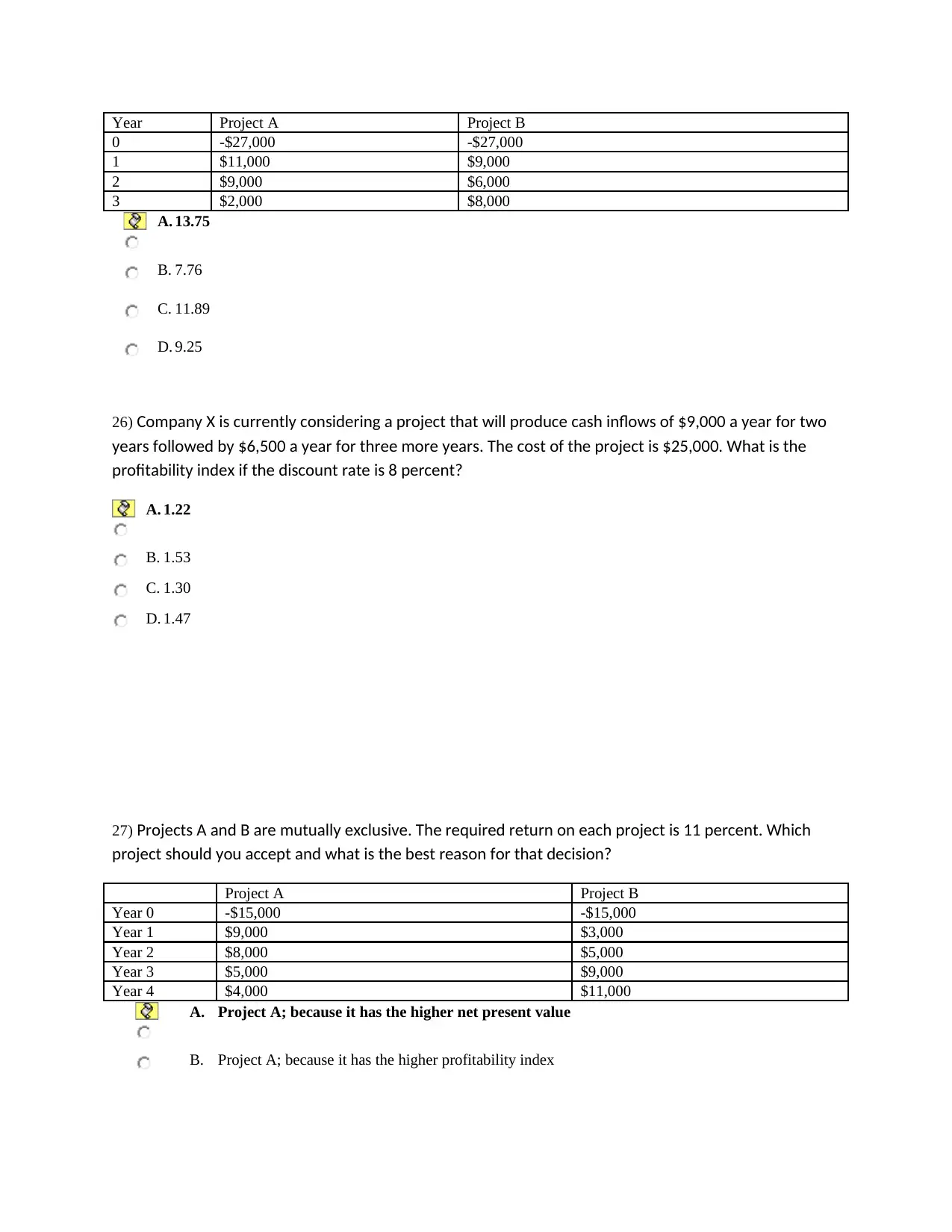
Year Project A Project B
0 -$27,000 -$27,000
1 $11,000 $9,000
2 $9,000 $6,000
3 $2,000 $8,000
A. 13.75
B. 7.76
C. 11.89
D. 9.25
26) Company X is currently considering a project that will produce cash inflows of $9,000 a year for two
years followed by $6,500 a year for three more years. The cost of the project is $25,000. What is the
profitability index if the discount rate is 8 percent?
A. 1.22
B. 1.53
C. 1.30
D. 1.47
27) Projects A and B are mutually exclusive. The required return on each project is 11 percent. Which
project should you accept and what is the best reason for that decision?
Project A Project B
Year 0 -$15,000 -$15,000
Year 1 $9,000 $3,000
Year 2 $8,000 $5,000
Year 3 $5,000 $9,000
Year 4 $4,000 $11,000
A. Project A; because it has the higher net present value
B. Project A; because it has the higher profitability index
0 -$27,000 -$27,000
1 $11,000 $9,000
2 $9,000 $6,000
3 $2,000 $8,000
A. 13.75
B. 7.76
C. 11.89
D. 9.25
26) Company X is currently considering a project that will produce cash inflows of $9,000 a year for two
years followed by $6,500 a year for three more years. The cost of the project is $25,000. What is the
profitability index if the discount rate is 8 percent?
A. 1.22
B. 1.53
C. 1.30
D. 1.47
27) Projects A and B are mutually exclusive. The required return on each project is 11 percent. Which
project should you accept and what is the best reason for that decision?
Project A Project B
Year 0 -$15,000 -$15,000
Year 1 $9,000 $3,000
Year 2 $8,000 $5,000
Year 3 $5,000 $9,000
Year 4 $4,000 $11,000
A. Project A; because it has the higher net present value
B. Project A; because it has the higher profitability index
Paraphrase This Document
Need a fresh take? Get an instant paraphrase of this document with our AI Paraphraser

C. Project B; because it has the higher profitability index
D. Project A; because it pays back faster
28) You are considering a project with an initial cost of $295,000, which will be fully depreciated over
three years. What is the average accounting return on this investment if it produces the following yearly
amounts of net income?
Year 1 2 3
Net Income $19,000 $16,800 $25,200
A. 17.19 percent
B. 10.34 percent
C. 13.79 percent
D. 6.89 percent
29) Corporation Z is considering a new project. This project requires an initial cash investment of
$70,000. The project will generate cash inflows of $10,500 in the first year. Then, the project will do
nothing for two years, after which time cash inflows of $25,000 will be generated for four years. How
long will it take Corporation Z Co. to recover its $70,000 investment?
A. 5.38 years
B. 6.11 years
C. 6.62 years
D. 5.16 years
30) Which one of the following statements is correct?
A. The payback rule is biased in favor of long-term projects.
B. The payback period ignores the time value of money.
C. The payback rule states that you should accept a project if the payback period is less than one
year.
D. A longer payback period is preferred over a shorter payback period.
31) Which one of the following is an example of erosion?
A. Company Z has an entire molding facility that is sitting idle due to the lack of demand for the firm’s
D. Project A; because it pays back faster
28) You are considering a project with an initial cost of $295,000, which will be fully depreciated over
three years. What is the average accounting return on this investment if it produces the following yearly
amounts of net income?
Year 1 2 3
Net Income $19,000 $16,800 $25,200
A. 17.19 percent
B. 10.34 percent
C. 13.79 percent
D. 6.89 percent
29) Corporation Z is considering a new project. This project requires an initial cash investment of
$70,000. The project will generate cash inflows of $10,500 in the first year. Then, the project will do
nothing for two years, after which time cash inflows of $25,000 will be generated for four years. How
long will it take Corporation Z Co. to recover its $70,000 investment?
A. 5.38 years
B. 6.11 years
C. 6.62 years
D. 5.16 years
30) Which one of the following statements is correct?
A. The payback rule is biased in favor of long-term projects.
B. The payback period ignores the time value of money.
C. The payback rule states that you should accept a project if the payback period is less than one
year.
D. A longer payback period is preferred over a shorter payback period.
31) Which one of the following is an example of erosion?
A. Company Z has an entire molding facility that is sitting idle due to the lack of demand for the firm’s
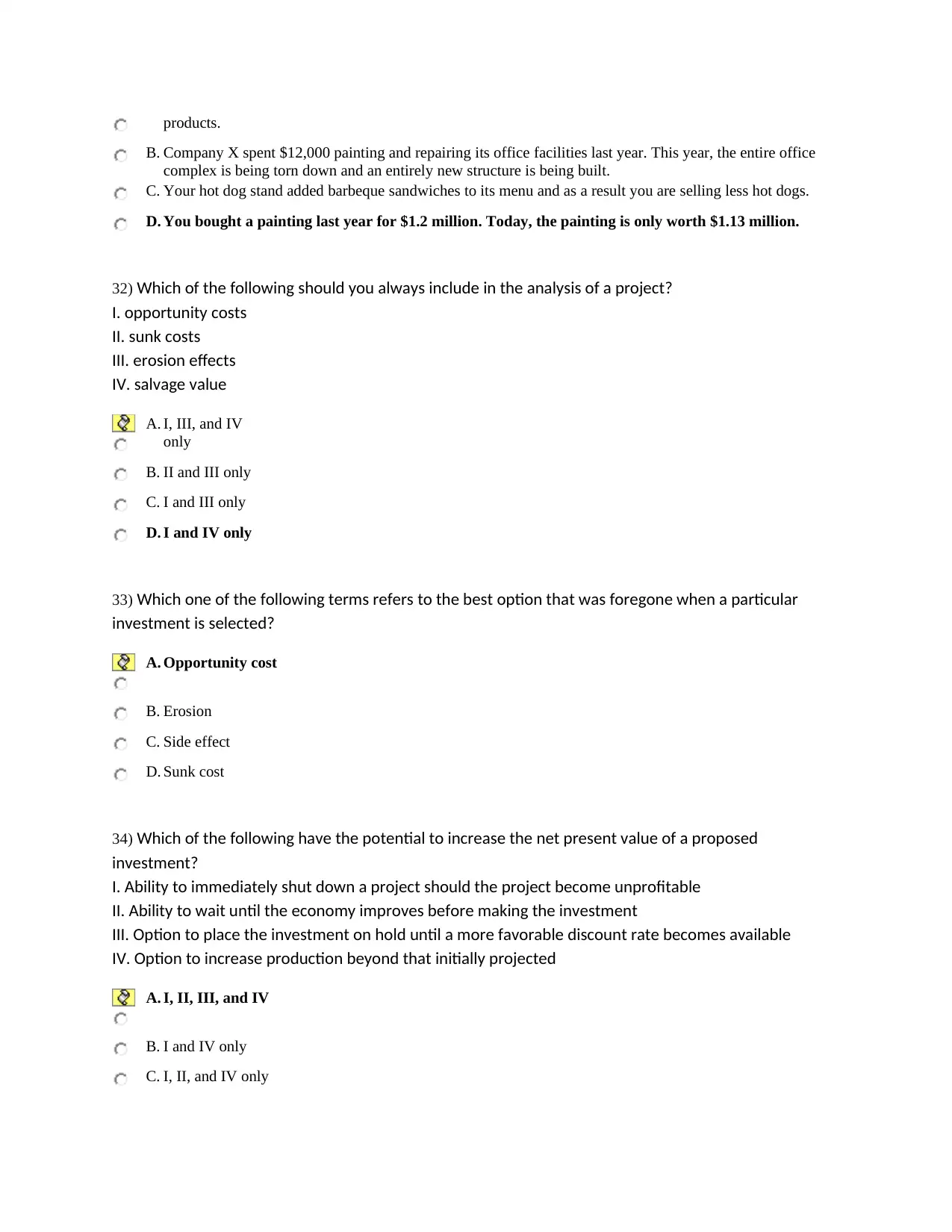
products.
B. Company X spent $12,000 painting and repairing its office facilities last year. This year, the entire office
complex is being torn down and an entirely new structure is being built.
C. Your hot dog stand added barbeque sandwiches to its menu and as a result you are selling less hot dogs.
D. You bought a painting last year for $1.2 million. Today, the painting is only worth $1.13 million.
32) Which of the following should you always include in the analysis of a project?
I. opportunity costs
II. sunk costs
III. erosion effects
IV. salvage value
A. I, III, and IV
only
B. II and III only
C. I and III only
D. I and IV only
33) Which one of the following terms refers to the best option that was foregone when a particular
investment is selected?
A. Opportunity cost
B. Erosion
C. Side effect
D. Sunk cost
34) Which of the following have the potential to increase the net present value of a proposed
investment?
I. Ability to immediately shut down a project should the project become unprofitable
II. Ability to wait until the economy improves before making the investment
III. Option to place the investment on hold until a more favorable discount rate becomes available
IV. Option to increase production beyond that initially projected
A. I, II, III, and IV
B. I and IV only
C. I, II, and IV only
B. Company X spent $12,000 painting and repairing its office facilities last year. This year, the entire office
complex is being torn down and an entirely new structure is being built.
C. Your hot dog stand added barbeque sandwiches to its menu and as a result you are selling less hot dogs.
D. You bought a painting last year for $1.2 million. Today, the painting is only worth $1.13 million.
32) Which of the following should you always include in the analysis of a project?
I. opportunity costs
II. sunk costs
III. erosion effects
IV. salvage value
A. I, III, and IV
only
B. II and III only
C. I and III only
D. I and IV only
33) Which one of the following terms refers to the best option that was foregone when a particular
investment is selected?
A. Opportunity cost
B. Erosion
C. Side effect
D. Sunk cost
34) Which of the following have the potential to increase the net present value of a proposed
investment?
I. Ability to immediately shut down a project should the project become unprofitable
II. Ability to wait until the economy improves before making the investment
III. Option to place the investment on hold until a more favorable discount rate becomes available
IV. Option to increase production beyond that initially projected
A. I, II, III, and IV
B. I and IV only
C. I, II, and IV only
⊘ This is a preview!⊘
Do you want full access?
Subscribe today to unlock all pages.

Trusted by 1+ million students worldwide

D. II and III only
35) The operating cash flow for a firm that pays taxes and has positive net income will:
A. increase when the depreciation expense is
increased.
B. increase when the tax rate increases.
C. increase when interest expense decreases.
D. decrease when sales increase.
36) The MACRS depreciation allowances on 3-year property are 33.33 percent, 44.44 percent, 14.82
percent, and 7.41 percent, respectively. What is the amount of the depreciation in year 2 for a 3-year
asset with an initial cost of $89,000?
A. $35,414.14
B. $39,551.60
C. $26,369.05
D. $33,333.33
37) Company Z estimates it can sell 900 units of a new product a year, plus or minus 4 percent. It also
estimates the selling price at $22 a unit, plus or minus 3 percent. What is the expected annual revenue
under the best case scenario?
A. $20,592
B. $20,394
C. $22,058
D. $21,210
38) Gloria’s is reviewing a project with projected sales of 895 units a year, plus or minus 5 percent. The
estimated sales price is $79 a unit, plus or minus 3 percent. Variable costs are estimated at $42 a unit,
plus or minus 2 percent, and the fixed costs are $19,000, plus or minus $500. What are the estimated
total costs under the worst case scenario?
35) The operating cash flow for a firm that pays taxes and has positive net income will:
A. increase when the depreciation expense is
increased.
B. increase when the tax rate increases.
C. increase when interest expense decreases.
D. decrease when sales increase.
36) The MACRS depreciation allowances on 3-year property are 33.33 percent, 44.44 percent, 14.82
percent, and 7.41 percent, respectively. What is the amount of the depreciation in year 2 for a 3-year
asset with an initial cost of $89,000?
A. $35,414.14
B. $39,551.60
C. $26,369.05
D. $33,333.33
37) Company Z estimates it can sell 900 units of a new product a year, plus or minus 4 percent. It also
estimates the selling price at $22 a unit, plus or minus 3 percent. What is the expected annual revenue
under the best case scenario?
A. $20,592
B. $20,394
C. $22,058
D. $21,210
38) Gloria’s is reviewing a project with projected sales of 895 units a year, plus or minus 5 percent. The
estimated sales price is $79 a unit, plus or minus 3 percent. Variable costs are estimated at $42 a unit,
plus or minus 2 percent, and the fixed costs are $19,000, plus or minus $500. What are the estimated
total costs under the worst case scenario?
Paraphrase This Document
Need a fresh take? Get an instant paraphrase of this document with our AI Paraphraser
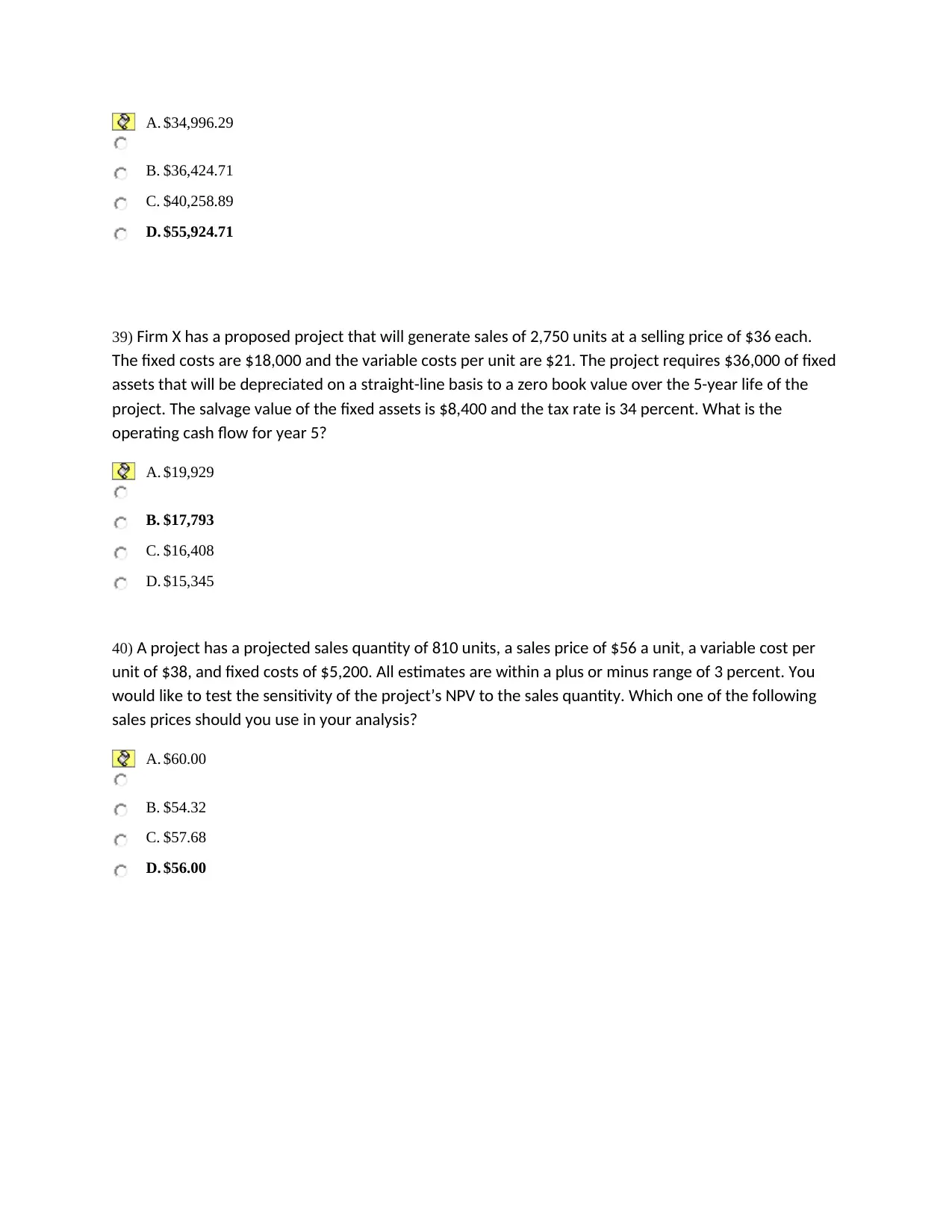
A. $34,996.29
B. $36,424.71
C. $40,258.89
D. $55,924.71
39) Firm X has a proposed project that will generate sales of 2,750 units at a selling price of $36 each.
The fixed costs are $18,000 and the variable costs per unit are $21. The project requires $36,000 of fixed
assets that will be depreciated on a straight-line basis to a zero book value over the 5-year life of the
project. The salvage value of the fixed assets is $8,400 and the tax rate is 34 percent. What is the
operating cash flow for year 5?
A. $19,929
B. $17,793
C. $16,408
D. $15,345
40) A project has a projected sales quantity of 810 units, a sales price of $56 a unit, a variable cost per
unit of $38, and fixed costs of $5,200. All estimates are within a plus or minus range of 3 percent. You
would like to test the sensitivity of the project’s NPV to the sales quantity. Which one of the following
sales prices should you use in your analysis?
A. $60.00
B. $54.32
C. $57.68
D. $56.00
B. $36,424.71
C. $40,258.89
D. $55,924.71
39) Firm X has a proposed project that will generate sales of 2,750 units at a selling price of $36 each.
The fixed costs are $18,000 and the variable costs per unit are $21. The project requires $36,000 of fixed
assets that will be depreciated on a straight-line basis to a zero book value over the 5-year life of the
project. The salvage value of the fixed assets is $8,400 and the tax rate is 34 percent. What is the
operating cash flow for year 5?
A. $19,929
B. $17,793
C. $16,408
D. $15,345
40) A project has a projected sales quantity of 810 units, a sales price of $56 a unit, a variable cost per
unit of $38, and fixed costs of $5,200. All estimates are within a plus or minus range of 3 percent. You
would like to test the sensitivity of the project’s NPV to the sales quantity. Which one of the following
sales prices should you use in your analysis?
A. $60.00
B. $54.32
C. $57.68
D. $56.00
1 out of 11
Related Documents
Your All-in-One AI-Powered Toolkit for Academic Success.
+13062052269
info@desklib.com
Available 24*7 on WhatsApp / Email
![[object Object]](/_next/static/media/star-bottom.7253800d.svg)
Unlock your academic potential
Copyright © 2020–2026 A2Z Services. All Rights Reserved. Developed and managed by ZUCOL.





